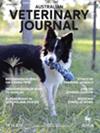Prevalence and classification of congenital thoracic vertebral body abnormalities in neurologically normal brachycephalic ‘screw-tail’ dog breeds in referral practice in Australia
Abstract
Objective
To evaluate the prevalence, type, site and breed predisposition of thoracic congenital vertebral malformations (CVM) in neurologically normal brachycephalic ‘screw-tail’ dog breeds.
Study Design
Retrospective case series.
Animals
Neurologically normal French Bulldogs (n = 63), British Bulldogs (n = 42), Boston Terriers (n = 4) and Pugs (n = 86) presenting for brachycephalic obstructive airway syndrome treatment.
Methods
Either a plain computer tomography scan of the thorax or lateral and dorso-ventral digital radiographs of the thoracic vertebral column of each dog were assessed for any vertebral malformations and classed according to the Modified McMaster vertebral abnormality classification scheme proposed by Guiterrez et al.
Results
The prevalence of dogs with one or more abnormal vertebrae was 96.82% in French Bulldogs, 90.47% in British Bulldogs, and 76.74% in Pugs. Pugs had significantly lower instances of CVMs than French Bulldogs. The four Boston Terriers all had vertebral malformations, but the results were not considered to be statistically significant due to their small sample size. In French Bulldogs and British Bulldogs, ventral hypoplasia (Type 3) occurred at greater rates than all other types, followed by ventral and median hypoplasia (Types 7) and symmetrical hypoplasia (Type 8). In Pugs, symmetrical hypoplasia (Type 8) was the most common and then ventral hypoplasia (Type 3). The most affected vertebrae were T6–T9 in Pugs and T5–T10 in French Bulldogs and British Bulldogs.
Conclusions
The majority of neurologically normal brachycephalic ‘screw-tail’ dogs assessed in this paper possessed one or more congenital thoracic vertebral malformations. Dogs with vertebral malformations were found to be more likely to have more than one affected vertebra. Sex had no effect on the prevalence of CVM.
Clinical Relevance
A substantial number of neurologically normal brachycephalic ‘screw-tail’ dogs suffer from congenital vertebral malformations. Thus, the need for selective breeding programmes to eliminate this hereditary condition is crucial.

 求助内容:
求助内容: 应助结果提醒方式:
应助结果提醒方式:


